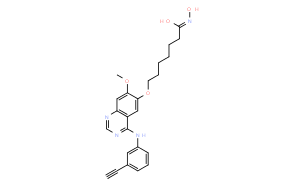
 COA COA |
 MSDS MSDS |
 HPLC HPLC |
 NMR NMR |
| CAS No: | 1012054-59-9 |
| Molecular formula(MF) | C24H26N4O4 |
| Molecular Weight(MW): | 434.49 |
| Alias | 7-(4-(3-ethynylphenylamino)-7-methoxyquinazolin-6-yloxy)-N-hydroxyheptanamide |
| In vitro | DMSO | 20 mg/mL (46.03 mM) |
|---|---|---|
| Water | <1 mg/mL | |
| Ethanol | <1 mg/mL | |
| In vivo | 15% Captisol | 30 mg/mL |
| Description | CUDC-101 is a potent multi-targeted inhibitor against HDAC, EGFR and HER2 with IC50 of 4.4 nM, 2.4 nM, and 15.7 nM, and inhibits class I/II HDACs, but not class III, Sir-type HDACs. Phase 1. | |||||||||||
|---|---|---|---|---|---|---|---|---|---|---|---|---|
| Targets |
|
|||||||||||
| In vitro |
Specific for class I and class II HDACs, CUDC-101 does not inhibit class III Sir-type HDACs. CUDC-101 displays weak activity against other protein kinases including KDR/VEGFR2, Lyn, Lck, Abl-1, FGFR-2, Flt-3, and Ret with IC50 of 0.85 μM, 0.84 μM, 5.91 μM, 2.89 μM, 3.43 μM, 1.5 μM, abd 3.2 μM, respectively. CUDC-101 displays broad antiproliferative activity in many human cancer cell types with IC50 of 0.04-0.80 μM, exhibiting a higher potency than erlotinib, lapatinib, and combinations of vorinostat with either erlotinib or lapatinib in most cases. CUDC-101 potently inhibits lapatinib- and erlotinib-resistant cancer cell lines. [1] CUDC-101 inhibits the erlotinib-resistant EGFR mutant T790M although its effects are incomplete with an Amax of ~60% of peak enzyme activity after inhibition. CUDC-101 treatment increases the acetylation of histone H3 and H4, as well as the acetylation of non-histone substrates of HDAC such as p53 and α-tubulin, in a dose-dependant manner in various cancer cell lines. CUDC-101 also suppresses HER3 expression, Met amplification, and AKT reactivation in tumor cells. [2] |
|||||||||||
| In vivo | Administration of CUDC-101 at 120 mg/kg/day induces tumor regression in the Hep-G2 liver cancer model, which is more efficacious than that of erlotinib at its maximum tolerated dose (25 mg/kg/day) and vorinostat at an equimolar concentration dose (72 mg/kg/day). CUDC-101 inhibits the growth of erlotinib-sensitive H358 NSCLC xenografts in a dose-dependent manner. CUDC-101 also shows potent inhibition of tumor growth in the erlotinib-resistant A549 NSCLC xenograft model. CUDC-101 produces significant tumor regression in the lapatinib-resistant, HER2-negative, EGFR-overexpressing MDA-MB-468 breast cancer model and the EGFR-overexpressing CAL-27 head and neck squamous cell carcinoma (HNSCC) model. Additionally, CUDC-101 inhibits tumor growth in the K-ras mutant HCT116 colorectal and EGFR/HER2 (neu)-expressing HPAC pancreatic cancer models. [1] |